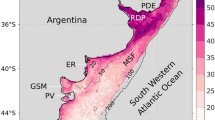Abstract
The mechanisms controlling the interannual variability of sea surface salinity (SSS) in the Atlantic are investigated using a simulation with the ECHAM4/OPA8 coupled model and, for comparison, the NCEP reanalysis and an observed SSS climatology. Anomalous Ekman advection is found to be as important as the freshwater flux in generating SSS anomalies, in contrast to sea surface temperature (SST) anomalies which are primarily caused by surface heat flux fluctuations. Since the surface heat flux feedback does not damp the SSS anomalies but generally damps existing SST anomalies, SSS anomalies have a larger characteristic time scale. As a result, they are more influenced by the mean currents and the geostrophic variability, which dominate the SSS changes at low frequency over much of the basin. The link between SSS anomalies and the dominant patterns of atmospheric variability in the North Atlantic sector is also discussed. It is shown that the North Atlantic Oscillation generates SSS anomalies much more by Ekman advection than by freshwater exchanges. At least in the coupled model, there is little one-to-one correspondence between the main atmospheric and SSS anomaly patterns, unlike what is found for SST anomalies.












Similar content being viewed by others
References
Alexander MA, Penland C (1996) Variability in a mixed layer ocean model driven by stochastic atmospheric forcing. J Clim 9: 2424–2442
Bojariu R, Reverdin G (2002) Large scale variability modes of freshwater flux and precipitation over the Atlantic. Clim Dyn 18: 369–381
Cayan DR (1992a) Latent and sensible heat flux anomalies over the northern oceans: the connection to monthly atmospheric circulation. J Clim 5: 354–369
Cayan DR (1992b) Latent and sensible heat flux anomalies over the northern oceans: driving the sea surface temperature. J Phys Oceanogr 22: 859–881
Dickson R, Meincke J, Malmberg S-A, Lee AJ (1988) The "Great Salinity Anomaly" in the northern North Atlantic 1968–1982. Prog Oceanogr 20: 103–151
Dickson R, Lazier J, Meincke J, Rhines P, Swift J (1996) Long term coordinated changes in the convective activity of the North Atlantic. Prog Oceanogr 38: 241–295
Frankignoul C (1985) Sea surface temperature anomalies, planetary waves and air–sea feedback in the middle latitudes. Rev Geophys 23: 357–390
Frankignoul C, Hasselmann K (1977) Stochastic climate models, Part II: application to sea-surface temperature anomalies and thermocline variability. Tellus 29: 289–305
Frankignoul C, Reynolds RW (1983) Testing a dynamical model for mid-latitude sea surface temperature anomalies. J Phys Oceanogr 13: 1131–1145
Frankignoul C, Kestenare E, Mignot J (2002) The surface heat flux feedback. Part II: direct and indirect estimates in the ECHAM4/OPA8 coupled GCM. Clim Dyn 19: 649–655
Guilyardi E, Delecluse P, Gualdi S, Naarra A (2003) Mechanisms for ENSO phase change in a coupled GCM. J Chim (in press)
Hall A, Manabe S (1997) Can local linear stochastic theory explain sea surface temperature and salinity variability. Clim Dyn 13: 167–180
Halliwell GR Jr (1998) Simulation of North Atlantic decadal/multidecadal winter SST anomalies driven by basin-scale atmospheric circulation anomalies. J Phys Oceanogr 28: 5–21
Hasselmann K (1976) Stochastic climate models, Part I: theory. Tellus 28: 473–485
Kalnay E and Coauthors (1996) The NCEP/NCAR 40-year reanalysis project. Bull Am Meteorol Soc 77: 437–471
Latif M, Roeckner E, Mikolajewicz U, Voss R (2000) Tropical stabilization of the thermohaline circulation in a greenhouse warming simulation. J Clim 13: 1809–1813
Madec G, Delecluse P, Imbart M, Levy C (1999) OPA8.1 Ocean general circulation model reference manual. Institut Pierre-Simon Laplace (IPSL), France. Report 11, pp 91
Marotzke J, Willebrand J (1991) Multiple equilibria of the global thermohaline circulation. J Phys Oceanogr 21: 1372–1385
Marshall J, Johnson H, Goodman J (2001) A study of the interaction of the North Atlantic Oscillation with ocean circulation. J Clim 14: 1399–1421
Mikolajewicz U, Maier-Reimer E (1990) Internal secular variability in an ocean general circulation model. Clim Dyn 4: 145–156
Rahmstorf S (1995) Bifurcations of the Atlantic thermohaline circulation in response to changes in the hydrological cycle. Nature 378: 145–149
Reverdin G, Durand F, Mortensen J, Schott F, Valdimarsson H, Zenk W (2002) Recent changes in the surface salinity of the North Atlantic subpolar gyre. J Geophys Res (in press)
Reverdin G, Cayan D, Kushnir Y (1997) Decadal variability of hydrography in the upper northern North Atlantic in 1948–1990. J Geophys Res 102: 8505–8531
Roeckner E, Arpe K, Bengtsson L, Christoph M, Claussen M, Dümenil L, Esch M, Giorgetta M, Schlese U, Schulzeida U (1996) The atmospheric general circulation model ECHAM-4: model description and simulation of present-day climate. Max-Planck-Institute für Meteorologie Rep 218, Hamburg, Germany, pp 90
Selten FM, Haarsma RJ Opsteegh JD (1999) On the mechanism of North Atlantic decadal variability. J Clim 12: 1956–1973
Smith TM, Reynolds RW, Livezey RE, Stokes DC (1996) Reconstruction of historical sea surface temperatures using empirical orthogonal functions. J Clim 9: 1403–1420
Spall MA (1993) Variability of sea surface salinity in stochastically forced systems. Clim Dyn 8: 151–160
Taylor AH, Stephens JA (1980) Seasonal and year-to-year variations in surface salinity at the nine North Atlantic ocean weather stations. Ocean Acta 3: 421–430
Acknowledgements
We would like to thank Eric Guyliardi and Gurvan Madec for providing the SINTEX run, Gilles Reverdin for useful comments and for making available his SSS climatology and Elodie ❚stenare for her help. The NCEP-NCAR reanalysis data were provided through the NOAA Climate Diagnostics Center (http://www.cdc.noaa.gov/ ). This research was supported in part by a grant from the PNEDC and by the SINTEX and PREDICATE projects of the European Community. Juliette Mignot was supported by a scholarship from the DGA-CNRS.
Author information
Authors and Affiliations
Corresponding author
Rights and permissions
About this article
Cite this article
Mignot, J., Frankignoul, C. On the interannual variability of surface salinity in the Atlantic. Climate Dynamics 20, 555–565 (2003). https://doi.org/10.1007/s00382-002-0294-0
Received:
Accepted:
Published:
Issue Date:
DOI: https://doi.org/10.1007/s00382-002-0294-0




